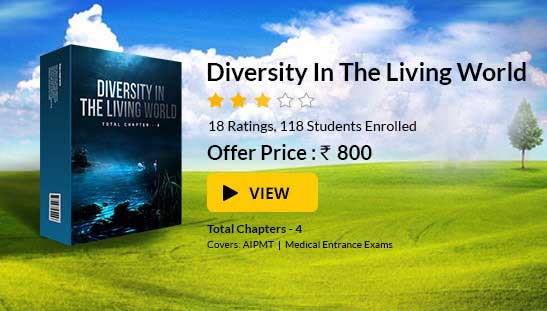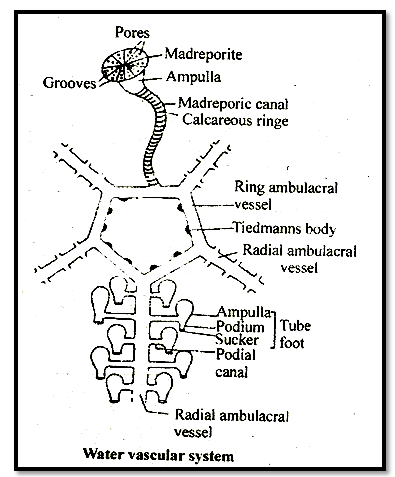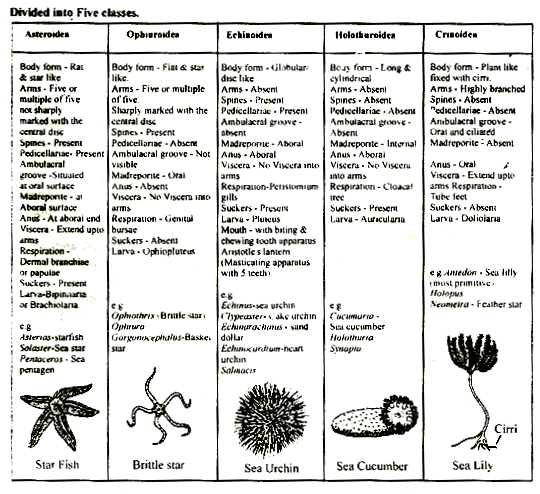Phylum- Annelida, Arthropoda, Mollusca and Echinodermata
-
PHYLUM - ANNELIDA
 Lamarck coined the term Annelida.Free living found in moist soil, fresh water, sea or few are parasite.Body is soft elongated, cylindrical or flattened divided into segments or metamers by ring like, groves called Annuli.
Lamarck coined the term Annelida.Free living found in moist soil, fresh water, sea or few are parasite.Body is soft elongated, cylindrical or flattened divided into segments or metamers by ring like, groves called Annuli.
Symmetry - Bilateral, Germ layer - Triploblastic, Level of organisation - Organ-system level having tube within tube plan.Anterior end forms a distinct head with sense organ in few annelids.Appendages are simple, unjointed, and locomotory having Chitinous Setae and ParapodiaBody wall consist of
(1) Cuticle - Thin moist albuminoid cutical allow free exchange of gas.
(2) Epidermis - Single layered epidermis made up of supporting cell, sensory and glandular cell.
(3) Muscle layer - (a) Circular layer, (b) Longitudinal layer. Muscle are smooth/unstraited.
Body wall may have minute chitinous setae.
First Protostomi eucoelomate animals.Body cavity is true coelom lined by mesodermal coelomic epithelium. Schizocoel.It is divided by transverse septa into compartment.It is filled with coelomic fluid that contains cells.As such there is no skeleton. Fluid filled coelom serves as a hydrostatic skeleton.
Digestive tract is complete, straight and extends through entire body. The gut has both circular and longitudinal muscles. Few annelids are sanguivorous. Digestive gland are developed for the first time in Annelida.
Respiration is through skin i.e. Cutaneous respiration. Some have gills (branchial respiration).
Circulatory system is closed. Some blood vessels enlarge to act as pumping heart. (Heart appear first time in annelids)
The blood is red with haemoglobin dissolved in plasma (Erythrocruorin). It has amoeboid corpuscles only. Few Annelids like Seballa have Chlorocruorin as a respiratory pigment also. Hirudinaria has circulatory system with haemocoelic system.
Excretory organ is Nephridia. Coiled tubules also helps in osmoregulation.
Excretory matter
(1) Ammonia in aquatic form
(2) Urea in land form
Nervous system consist of –
A circumenteric nerve ring, Double, midventral nerve cord with ganglia. Sence organ chemoreceptor, photoreceptor & tentacle, palp, eyes may be present.
Sexes may be separate or united. Asexual reproduction by budding' or fission in some cases also. Atoke (asexual), Epitoke (sexual) Phenomenon also found (Nereis).
Cleavage is spiral and determinate unqual & holoblastic.
Regeneration is usually found. Life history induds a trochophore larva in few Annelids.
Nereis: Inhabits in sea - shore between tide mark, burrows, Nocturnal, Carnivorous, Gregarious, Fertilization - in sea.
Parapodia in each segment except first & last.
During breeding body divides in two parts anterior asexual part - Atoke and posterior sexual portion Epitoke. This change is known as epitoky.

- UNIQUE FEATURES
- To suck impure blood by leach is called Phlebotomy.
- Metameric segmentation
- Nephridia for excretion and osmoregulation.
- Closed circulatory system with respiratory pigment dissolved in the plasma.
- Setae in the body wall in most forms.
- Head, appendages and respiratory organs in some cases,
- Circular and longitudinal muscles in both body wall and gut wall.
- "Annelida" is classified into 4 classes on the basis of presence or absence of sense organ and position of setae

-
PHYLUM-ARTHROPODA
Arthropoda is the biggest phylum. About 9,00,000 species are there.
Von Siebold established phylum Arthropoda.
Arthopods are found in water, land, sea, in plant and animal. They are colonial, gregarious, shows parental care.
Sometime Parthenogenesis phenomenon also found i.e. Development of an unfertilized egg into an offspring.
Phylum incudes crabs, prawn, insects, spider, scorpian, ticks, mite, centipedes, millipedes. Fossil arthropoda are called Trilobites.
Body is Bilateral, Triploblastic with organ system level of organisation
Head is distinct [High degree of cephalization], Consists of many fused segments that bears well developed sense organ such as eyes, compound eyes, antennae.
Compound eye consists of many similar units ommatidia each having lens and capable of forming image.
Arthropoda have various shapes with externally segmented body. Segmention is either
a) Two, region with Head and trunk or Cephalothorax and abdomen
b) Three region with head, thorax & abdomen some or all segments bear jointed appendages. Hence name arthro joints, pod a - foot.
No internal segmentation like Annelida
Body wall consists of:
Thick chitinous cuticle:
Cuticle composed of protein & polysaccharide chitin which is further strengthen by deposition of mineral (calcium phosphate & carbonate)
Flexible part of cuticle is called suture.
Wings of insects - chitinous.
Chitinous plates which form exoskeleton are known as sclerites.
Epidermis:
Single layered epidermis without cilia & flagella.
Muscle:
Muscle are arranged in bundles.
Muscle are striped/straited - Voluntary (first time devepoled in arthropods)
Due to presence of joints muscle are separate in them.
Body cavity around viscera contain blood and is called the haemocoel. True coelom is reduced to cavities in reproductive organs (gonads) & excretory organs. Coelom of gonads is called gonocoel and of nephrons is called nephrocoel.
Digesive tract is complete
It has divided into three parts:
(1) Stomodaeum (Anterior)
(2) Mesenteron (Mid de)
(3) Proctodaeum (Posterior)
Straited muscles are found in digestive tract.
Mouth parts adapated for-
(1) Biting and chewing: Biting and chewing type:
Grasshopper, Cockroach, Termites, Caterpillers.
(2) Piercing- Sucking type - Mosquitose, Bugs, Fleas.
(3) Chewing- lapsing type – Bee
(4) Sponging type - Housefly, fruitfly.
(5) Siphoning type - Butterflies, moths
Respiration is through body surface or special structure such as gills (e.g. Prawn), Trachea (e.g - Insects), Book-lungs (e.g. Scorpion), Book-gills (e.g. King crabs) . Trachea carry oxygen direct to the cells.
Circulatory system is open i.e. blood flows in hoemocoel instead of blood vessels.Blood - with white corpuscle, colourless Haemolymph. (e.g. Insect).
- Copper containing pigment haemocynain (e.g. Prawn)
Heart - A dorsal, tubular pulsatile, one to many chambered tubular structure.
Excretory organs are –
(1) Antennary or green glands-or maxillary gland (e.g. Crustaceans) opening directly to the exterior.
(2) Coxal gland (e.g. Arachnids)
(3) Malphigian tubules (e.g. Insects) opening into the gut.
Excretory matter is ammonia in aquatic animal and uric acid in land animal.
Nervous system comprises of a circumenteric ring and a double, solid midventral nerve cord bearing a pair of ganglia per segment or less (Ganglia).
Insects communicate by pheromones by releasing chemical into the environment. Also acts "on a sex attraction. Sexes are separate. Fertilization internal but few aquatic has external. Gonads have ducts. Larva stage undergoes degree of metamorphosis."
"Sexual dimorphism may be present. Mostly oviparous, Few viviparous.
Animals of arthropoda are most successful invaders of terrestrial environment in invertebrates due to presence of (1) Cuticle (2) Appendages (3) Wings
- UNIQUE FEATURES
- Jointed appendages modified for a variety of functions.
- Tough, Jointed exoskeleton of chitinous plates.
- Tracheae for respiration in majority of cases.
- Compound eyes.
- Malpighian tubules for excretion.
- Power of flight in most insects.
- "Striped muscles arranged in bundles for moving" particular parts,
WITNESS FEW ARTHROPODS






-
PHYLUM - MOLLUSCA
It is second largest phylum.
Mollusca (Soft bodied) are marine, some are found in fresh water or on land.
Johnston coined the name-Mollusca.
Study of this phylum is known as Malacolog & study of shells of molluscan is know as Choncology.
Body is unsegmented with variety of shapes Neopilina is exceptionally segmented.
Molluscns are usually bilateral. Few are secondarily asymmetrical (snail) due to twisting (snail) during growth. These are triploblastic with system level.
Body wall includes one layered epidermis (usually ciliated) with unstriped muscles found in bundles.
Body parts consist of
(1) Head with sense organ. Head is absent in Pelecypoda & Scaphopoda.
(2) Dorsal visceral mass containing organ system.
(3) Ventral foot for locomotion.
(4) Thin fleshy fold or outgrowth of dorsal wall covers the body. This fold is called-man pallium. It encloses a space mantle or pallial cavity, between itself and 'the body.
The mantle usually secretes-an external limy shell.
Shell is made up of calcium carbonate and choncheolin protein.
Shell may also be internal (Cuttle fish), reduced and even absent (Octopus)
Coelom is greatly reduced. It is represented by cavities in the pericardium, kidneys and gonads. Space among the viscera contain blood and form haemocoel.
Digestive tract is complete. Buccal cavity contain a rasping organ the Radula, with" transverse row of teeth. Anus opens into the mantle cavity. Digestive glands are known as hepatopancreas.
Respiration is usually by gills i.e. Ctenidia are in the mantle cavity but respiration may takes place by body surface also. Dentalium respire by mantle. Pila respire by pulmonary sac on land and by gills in water.
Circulatory system is open. It includes dorsal pulsatile heart and a few arteries that open into sinuses. Cephalopoda has closed type of circulatory system
Blood has a copper containing, blue respiratory pigment Haemocyanin. Blood is colourless with amoebocytes.
Excretory system includes 1 or 2 pairs of sac like kidneys, which open into the mantle cavity. Kidney of molluscans are Metanephridia known as Kaber's organs or Organ of Bojanus. Excretory matter is ammonia or uric acid.
Nervous system comprises three paired ganglia
(1) Cerebral (above the mouth)
(2) Pedal (in the foot)
(3) Visceral (in visceral mass)
These are inter connected by
(1) Commissure (Joins similar ganglia)
(2) Connectives (Joins dissimilar ganglia)
Senses organ includes
(1) Eye - Present over a stalk called ommatophore (Gastropoda).
(2) Statocyst/Lithocyst - For equilibrium in foot
(3) Osphradia - Chemoreceptor/Olfactory as well as for testing chemical & physical nature of water.
Sexes usually separate (snail has ovotestis). Gonads have ducts. Fertilization may be external or internal. Cleavage is spiral, determinate, unequal and holoblastic.
Development is - Direct or indirect. Trochophore is very common larva of Mollusca phylum.
Larva: Glochidium (Fresh water mussel) and Veliger, (Pilo)
- UNIQUE FEATURES
Precious pearl of the size of tennis- ball is made by a mollusc- Tridekna
"Nacre layer" is called "Mother of Pearl": This layer is made up of CaCO3 and choncheolin protetn.
Father of pearl industry - Koklchi Mikinimoto.
Molluscs are classified on the basis of shell, Foot, Nervous system and .Gills into seven classes.
- UNIQUE FEATURES
Three body regions: head, visceral mass and foot.
A glandular fold, the mantle, over the body,
Mantle cavity with anal, excretory and genital apertures in it.
Calcareous shell around the body in most cases.
A rasping organ, the radula, in the buccal cavity.
Much better sense organs, such as eyes, statocysts, osphradia, etc.
WITNESS FEW MOLLUSCS



-
PHYLUM - ECHINODERMATA
Name Echinodermata was given by Jacab Klein.
All are Marine except Synapta similis.
Generally live at bottom and slow moving.
Body shape is star like, cylindrical like, melon-like disc-like. flower like.
Body unsegmented with bilateral symmetry in larva and radial pentamerous (arranged in five or multiple) in adult.
Echinoderms are triploblastic with organ - system level of organisation
Echinoderms do not have head.
Tube feet (podia) which comes out through radial area i.e. Ambulacral used for locomotion. They are extended and retracted by variation in hydraulic pressure of fluid in them and by contraction of their muscles.
Body wall of echinoderms consists of
(1) Epidermis - Single layered & ciliated.
(2) Dermis - Below the epidermis thick dermis having mesodermal endoskeleton of calcareous plate (Ossicles). It has spines.
(3) Muscles - Smooth and lie below dermis. Minute pincer like structure pedicellariae comes out through skin. They keep body surface clear of debris by opening & closing.
Echinoderms have true coelom lined by ciliated mesothelium. Enterocoelous contain fluids with free amoeboid cells called coelomocytes.
Coelom is divided into many tubes and sinuses, which together form 3 systems,
(1) A unique water filled ambulacral or water vascular system with tube feet to help in locomotion. A perforated plate madreporite permits entry of water into ambulacral system which also help in food and gas transport system. Structures like Pollian vesicle, tiedmann body or recemose, stone canal are also found in water vascular system.
(2) Haemal system.
(3) Perihaemal system.

Respiration takes place by gills called dermal branchiae or papulae in most of Echinoderms like Starfish.
By genital bursae in Brittle star, By cloacal respiratory trees Sea- Cucumber, By Peristomial gills - Sea urchin
By Tube - feet in few echinoderms
Digestive tract is complete, (incomplete - brittle star).
Circulation system is reduced and open type called haemal system/ Perihaemal system. No heart or pumping vessel.
There is no excretory organ system. Nitrogenous waste (ammonia, diffuses out via gills, bursae, respiratory trees and tube feet. Amoeboid cells in coelomic fluid also perform excretory function by absorbing excretory matter.
Nervous system is simple and premitive type includes a Nerve ring and radial nerve cord 'with simple sense organ. (No brain)
Echinoderms resemble chordates in early embryonic development.
Echinoderms have separate sexes.
Fertilization is external (no copulation). Life history includes ciliated, bilaterally symmetrical larva that undergoes metamorphosis and' change into a adult (Deuterostoms).
- Larva
Star fish → Bipinnaria
Brittle star → Ophiopluteus
Sea urchin → Echinopluteus
Sea cucumber → Auricularia
Feather star → Doliolaria,
Few echinoderms (star fish) have great power of regeneration. They break off their arms for defence purpose. This phenomenon is known as Autotomy.
Echinoderms in angry or frightened state vomits out viscera (internal organ). This phenomenon is known as Evisceration.
Heart urchin has lophophore (Ciliary structure) Echinodermata has been classified into
(1) Sub phylum - Echinozoa - Class Holothuroidea, Echinoidea
(2) Sub phylum - Crinozoa - Class - Crinoidea.
(3) Sub phylum - Asterozoa - Class - Asteroidea, Ophiuroidea.
- UNIQUE FEATURES
Bilateral symmetry in the larva and radial symmetry in the adult.
Mesodermal endoskeleton of calcarous plates, usually with spines.
Modification of a part of the coelom into a water vascular system for aid in locomotion.
Characteristic tube feet for locomotion.
Peculiar pedicellariae for cleaning the body surface.

To read more, Buy study materials of Animal Kingdom comprising study notes, revision notes, video lectures, previous year solved questions etc. Also browse for more study materials on Biology here.
View courses by askIITians


Design classes One-on-One in your own way with Top IITians/Medical Professionals
Click Here Know More

Complete Self Study Package designed by Industry Leading Experts
Click Here Know More

Live 1-1 coding classes to unleash the Creator in your Child
Click Here Know More
